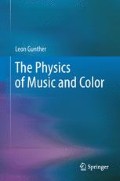Abstract
We are all aware that electricity is needed to operate an audio amplifier. We casually say that we cannot get something for nothing. We pay the electric company an amount that is based on the number of kilowatt-hours of electricity used. In fundamental physics terms, electricity is a form of energy that is needed to power and operate an amplifier. The expenses of the electric company include the production of electrical energy from other forms of energy and the transmission of this form of energy from the electrical generator plants to your home.
Access this chapter
Tax calculation will be finalised at checkout
Purchases are for personal use only
Notes
- 1.
We can estimate the energy per unit length as follows: a unit length has a mass \(m = \mu (1) = \mu \). Its average speed should be a bit less than the maximum velocity v m . Thus, its KE should be a bit less than \((1/2)m{{v}_{m}}^{2} = (1/2)\mu {{v}_{m}}^{2}\). This turns out to be the exact answer; it includes the PE too. Of course, \(\mathit{KE} = \mathit{PE} = \mathrm{constant}\).
Recall that v m = 2πfA (see 4.8). Thus, the energy per unit length is proportional to the square of the amplitude A, as in the case of the energy of a standing wave.
- 2.
The mere existence of sunspots tells us that the emission of light from the SUN cannot be perfectly isotropic.
- 3.
The range of sensitivity and tolerance of vision to light intensities is also understood to be about twelve orders of magnitude, from \(\sim 1{0}^{-10}\,{\mathrm{W/m}}^{2}\) to ∼ 100 W∕m2.
- 4.
An excellent website for appreciating changes in sound levels is http://www.phys.unsw.edu.au/~jw/dB.html.
- 5.
It is essential to keep in mind that even in the absence of attenuation, the intensity of a wave that is emitted by a point source will decrease according to the “inverse square law” of 4.19. Attenuation will produce an additional contribution to the decrease in the intensity with increasing distance from the point source.
- 6.
We have \({\alpha }_{\mathrm{L}} =\ln 2/(\mbox{ attenuation length})\).
- 7.
The graph was produced using the standard ISO 9613-1:1993.See http://www.iso.org/iso/catalogue_detail.htm?csnumber=17426. I obtained the formula from the website (2-2-2011): http://www.sengpielaudio.com/AirdampingFormula.htm. I am grateful to Eberhard Sengpiel for his help.
- 8.
Analysis leads to: [attenuation constant in m − 1] = \([0.00005\ln (10)] \times [\mbox{ attenuation in dB/km}] = 0.00012[\mbox{ attenuation in dB/km}]\).
- 9.
For more information on the reverberation time, see the website: http://www.yrbe.edu.on.ca/~mdhs/music/oac_proj97/music/reverb.html. You will be able to calculate the reverberation time of a room given the volume of the room and the area and absorption constant of each surface within the room.
Author information
Authors and Affiliations
Corresponding author
Rights and permissions
Copyright information
© 2012 Springer Science+Business Media, LLC
About this chapter
Cite this chapter
Gunther, L. (2012). Energy. In: The Physics of Music and Color. Springer, New York, NY. https://doi.org/10.1007/978-1-4614-0557-3_4
Download citation
DOI: https://doi.org/10.1007/978-1-4614-0557-3_4
Published:
Publisher Name: Springer, New York, NY
Print ISBN: 978-1-4614-0556-6
Online ISBN: 978-1-4614-0557-3
eBook Packages: Physics and AstronomyPhysics and Astronomy (R0)

